-

新人教版高中英语选修2Unit 2 Reading for writing教学设计
The theme of this section is to express people's views on studying abroad. With the continuous development of Chinese economic construction, especially the general improvement of people's living standards, the number of Chinese students studying abroad at their own expense is on the rise. Many students and parents turn their attention to the world and regard studying abroad as an effective way to improve their quality, broaden their horizons and master the world's advanced scientific knowledge, which is very important for the fever of going abroad. Studying abroad is also an important decision made by a family for their children. Therefore, it is of great social significance to discuss this issue. The theme of this section is the column discussion in the newspaper: the advantages and disadvantages of studying abroad. The discourse is about two parents' contribution letters on this issue. They respectively express their own positions. One thinks that the disadvantages outweigh the advantages, and the other thinks that the advantages outweigh the disadvantages. The two parents' arguments are well founded and logical. It is worth noting that the two authors do not express their views on studying abroad from an individual point of view, but from a national or even global point of view. These two articles have the characteristics of both letters and argumentative essays1.Guide the students to read these two articles, and understand the author's point of view and argument ideas2.Help the students to summarize the structure and writing methods of argumentative writing, and guides students to correctly understand the advantages and disadvantages of studying abroad3.Cultivate students' ability to analyze problems objectively, comprehensively and deeply

新人教版高中英语选修2Unit 2 Using langauge-Listening教学设计
? B: Absolutely! Getting involved with Chinese cultural activities there definitely helped a lot. I got to practice my Chinese on a daily basis, and I could learn how native Chinese speakers spoke.? A: What do you feel is your biggest achievement?? B: Learning Chinese characters! I have learnt about 1,500 so far. When I first started, I didn't think it was even going to be possible to learn so many, but now I find that I can read signs, menus, and even some easy newspaper articles.? A: What are you most keen on?? B: I've really become keen on learning more about the Chinese culture, in particular Chinese calligraphy. As I have learnt Chinese characters, I have developed a great appreciation for their meaning. I want to explore Chinese characters by learning how to write them in a more beautiful way. ? A: Finally, what do you want to say to anyone interested in learning Chinese?? I have really become keen on learning more about the Chinese culture, in particular Chinese Calligraphy. As I have learnt Chinese character, I have developed a great appreciation for their meaning. I want to explore Chinese characters by learning how to write them in a more beautiful way.? A: Finally, what do you want to say to anyone interested in learning Chinese?? B: I'd say, give it a shot! While some aspects may be difficult, it is quite rewarding and you will be happy that you tried.? A: Thanks for your time. ? B:You're welcome.

新人教版高中英语选修2Unit 4 Learning about Language教学设计
This section guides students to pay attention to the typical context of vocabulary use, helps students accumulate vocabulary around the key vocabulary of this unit, and uses the learned words and word chunks in different contexts to deeply understand their meaning and usage, so as to achieve the purpose of review and consolidation.The teaching design activities aim to guide students to pay attention to the typical context in which the target vocabulary is used, as well as the common vocabulary used in collocation, so that students can complete the sentence with correct words. In terms of vocabulary learning strategies, this unit focuses on cultivating students' ability to pay attention to collocation of words and to use word blocks to express meaning.For vocabulary learning, it is not enough just to know the meaning of a single word, but the most important thing is to master the common collocations of words, namely word blocks.Teachers should timely guide students to summarize common vocabulary collocation, such as verb and noun collocation, verb and preposition collocation, preposition and noun collocation, and so on.1. Guide students to understand and consolidate the meaning and usage of the vocabulary in the context, 2. Guide the students to use the unit topic vocabulary in a richer context3. Let the students sort out and accumulate the accumulated vocabulary, establishes the semantic connection between the vocabulary,4. Enable students to understand and master the vocabulary more effectivelyGuiding the Ss to use unit topic words and the sentence patterns in a richer context.

新人教版高中英语选修2Unit 4 Reading for writing教学设计
假定你是英国的Jack,打算来中国旅行,请你给你的中国笔友李华写一封信,要点如下:1.你的旅行计划:北京→泰山→杭州;2.征求建议并询问他是否愿意充当你的导游。注意:1.词数80左右(开头和结尾已给出,不计入总词数);2.可以适当增加细节,以使行文连贯。参考词汇:故宫 the Forbidden City;泰山 Mount TaiDear Li Hua,I'm glad to tell you that 'm going to visit China.First,I am planning to visit Beijing,the capitalof China,where I am looking forward to enjoying the Great Wall,the Forbidden City and somebeautiful parks.Then I intend to go to visit Mount Tai in Shandong Province.I've heard that it is one ofthe most famous mountains in China and I can't wait to enjoy the amazing sunrise there.After that,I amalso going to Hangzhou.It is said that it is a beautiful modern city with breathtaking natural sights,among which the West Lake is a well- known tourist attraction.What do you think of my travel plan? Will you act as my guide? Hope to hear from you soon.

新人教版高中英语选修2Unit 4 Using langauge-Listening教学设计
The theme of the listening section is " talking about scenery and culture along a journey."The part is designed to further lead the students to understand Canadian natural geography and social environment, and integrated into the cultural contrast by mentioning the long train journey from Beijing to Moscow routes. On this basis, the part activates students related travel experience, lets the student serial dialogue, guides the student to explore further the pleasure and meaning of the long journey, and Chinese and foreign cultural comparison.The part also provides a framework for the continuation of the dialogue, which is designed to provide a framework for students to successfully complete their oral expressions, and to incorporate an important trading strategy to end the dialogue naturally.1. Help students to understand and master some common English idioms in the context, and experience the expression effect of English idioms.2. Guide the students to understand the identity of different people in the listening context, and finish the dialogue according to their own experience.3. Instruct the students to use appropriate language to express surprise and curiosity about space and place in the dialogue, and master the oral strategy of ending the dialogue naturally.1. Instruct students to grasp the key information and important details of the dialogue.2. Instruct students to conduct a similar talk on the relevant topic.

新人教版高中英语选修2Unit 5 Learning about Language教学设计
The purpose of this section of vocabulary exercises is to consolidate the key words in the first part of the reading text, let the students write the words according to the English definition, and focus on the detection of the meaning and spelling of the new words. The teaching design includes use English definition to explain words, which is conducive to improving students' interest in vocabulary learning, cultivating their sense of English language and thinking in English, and making students willing to use this method to better grasp the meaning of words, expand their vocabulary, and improve their ability of vocabulary application. Besides, the design offers more context including sentences and short passage for students to practice words flexibly.1. Guide students to understand and consolidate the meaning and usage of the vocabulary in the context, 2. Guide the students to use the unit topic vocabulary in a richer context3. Let the students sort out and accumulate the accumulated vocabulary, establishes the semantic connection between the vocabulary,4. Enable students to understand and master the vocabulary more effectivelyGuiding the Ss to use unit topic words and the sentence patterns in a richer context.Step1: Read the passage about chemical burns and fill in the blanks with the correct forms of the words in the box.

新人教版高中英语选修2Unit 5 Reading and thinking教学设计
The theme of this activity is to learn the first aid knowledge of burns. Burns is common in life, but there are some misunderstandings in manual treatment. This activity provides students with correct first aid methods, so as not to take them for granted in an emergency. This section guides students to analyze the causes of scald and help students avoid such things. From the perspective of text structure and collaborative features, the text is expository. Expository, with explanation as the main way of expression, transmits knowledge and information to readers by analyzing concepts and elaborating examples. This text arranges the information in logical order, clearly presents three parts of the content through the subtitle, accurately describes the causes, types, characteristics and first aid measures of burns, and some paragraphs use topic sentences to summarize the main idea, and the level is very clear.1. Guide students to understand the causes, types, characteristics and first aid methods of burns, through reading2. Enhance students’ ability to deal withburnss and their awareness of burns prevention3. Enable students to improve the ability to judge the types of texts accurately and to master the characteristics and writing techniques of expository texts.Guide students to understand the causes, types, characteristics and first aid methods of burns, through readingStep1: Lead in by discussing the related topic:1. What first-aid techniques do you know of ?CPR; mouth to mouth artificial respiration; the Heimlich Manoeuvre

新人教版高中英语选修2Unit 5 Using langauge-Listening教学设计
The theme of this section is to learn how to make emergency calls. Students should learn how to make emergency calls not only in China, but also in foreign countries in English, so that they can be prepared for future situations outside the home.The emergency telephone number is a vital hotline, which should be the most clear, rapid and effective communication with the acute operator.This section helps students to understand the emergency calls in some countries and the precautions for making emergency calls. Through the study of this section, students can accumulate common expressions and sentence patterns in this context. 1.Help students accumulate emergency telephone numbers in different countries and learn more about first aid2.Guide the students to understand the contents and instructions of the telephone, grasp the characteristics of the emergency telephone and the requirements of the emergency telephone.3.Guide students to understand the first aid instructions of the operators.4.Enable Ss to make simulated emergency calls with their partners in the language they have learned1. Instruct students to grasp the key information and important details of the dialogue.2. Instruct students to conduct a similar talk on the relevant topic.Step1:Look and discuss:Match the pictures below to the medical emergencies, and then discuss the questions in groups.
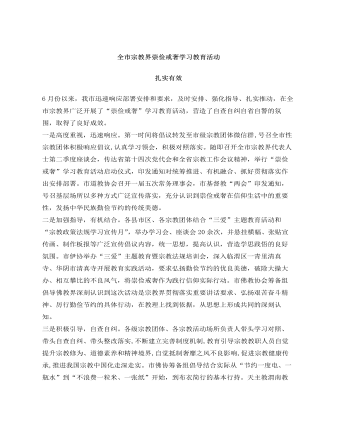
全市宗教界崇俭戒奢学习教育活动总结汇报
天主教渭南教区举行“崇俭戒奢”教育活动座谈会,进一步统一思想认识,清醒认识宗教领域贪大求奢、借教敛财、铺张浪费等不良风气的严重危害,突出问题导向,坚持自查自改,要求秉持俭朴理念,发扬勤俭节约、朴实无华、清净庄严等优良传统,使厉行节约、崇尚简朴的理念在全市天主教界蔚然成风。四是固化经验,常抓抓常。按照省民宗委、各全省性宗教团体统一部署要求和总体安排,一是结合“三爱”主题教育和爱国主义教育活动,广泛深入推进“崇俭戒奢”宣传教育,以实际行动响应倡议,以实际成效树立形象,扎实推进我国宗教中国化。二是引导各级宗教团体持续拓展中国化内涵,把“三爱”主题教育与“四进”活动相结合,突出自身特点、时代精神、中国特色,推动“崇俭戒奢”教育活动深入人心、落地见效。三是督导各宗教场所提高站位、深化认识,发扬宗教适应社会、服务社会的优良传统,增强政治自觉和行动自觉,为社会主义现代化和中华民族伟大复兴更好的发挥宗教积极作用。
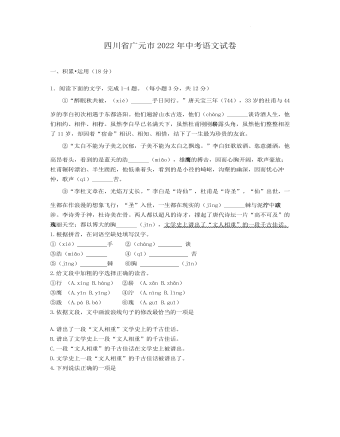
2022年四川省广元市中考语文试卷及答案
予谓菊,花之隐逸者也;牡丹,花之富贵者也;莲,花之君子者也。噫!菊之爱,陶后鲜有闻。莲之爱,同予者何人?牡丹之爱,宜乎众矣。
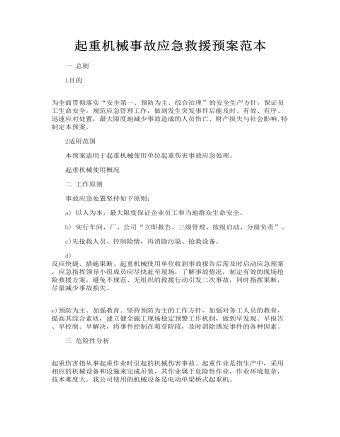
起重机械事故应急救援预案范本
二 工作原则 事故应急处置坚持如下原则: a) 以人为本,最大限度保证企业员工和当地群众生命安全。 b) 实行车间、厂、公司“立即报告、三级管理、按级启动、分级负责”。 c)先抢救人员、控制险情,再消除污染、抢救设备。 d) 反应快捷、措施果断。起重机械使用单位收到事故报告后需及时启动应急预案,应急指挥领导小组成员应尽快赶至现场,了解事故情况,制定有效的现场抢险救援方案,避免不规范、无组织的救援行动引发二次事故,同时指挥果断,尽量减少事故损失。
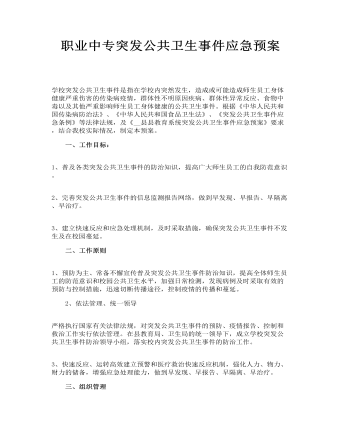
职业中专突发公共卫生事件应急预案
一、工作目标: 1、普及各类突发公共卫生事件的防治知识,提高广大师生员工的自我防范意识。 2、完善突发公共卫生事件的信息监测报告网络,做到早发现、早报告、早隔离、早治疗。 3、建立快速反应和应急处理机制,及时采取措施,确保突发公共卫生事件不发生及在校园蔓延。
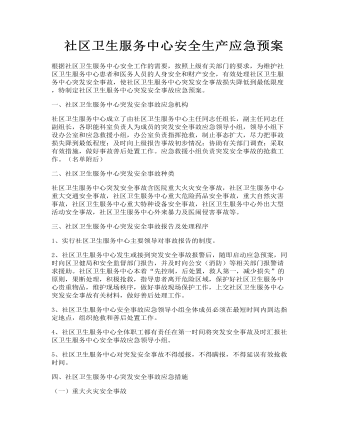
社区卫生服务中心安全生产应急预案
二、社区卫生服务中心突发安全事故种类社区卫生服务中心突发安全事故含医院重大火灾安全事故,社区卫生服务中心重大交通安全事故,社区卫生服务中心重大危险药品安全事故,重大自然灾害事故,社区卫生服务中心重大特种设备安全事故,社区卫生服务中心外出大型活动安全事故,社区卫生服务中心外来暴力及医闹侵害事故等。三、社区卫生服务中心突发安全事故报告及处理程序1、实行社区卫生服务中心主要领导对事故报告的制度。2、社区卫生服务中心发生或接到突发安全事故报警后,随即启动应急预案,同时向区卫健局和安全监督部门报告,并及时向公安(消防)等相关部门报警请求援助。社区卫生服务中心本着“先控制,后处置,救人第一,减少损失”的原则,果断处理,积极抢救,指导患者离开危险区域,保护好社区卫生服务中心贵重物品,维护现场秩序,做好事故现场保护工作,上交社区卫生服务中心突发安全事故有关材料,做好善后处理工作。
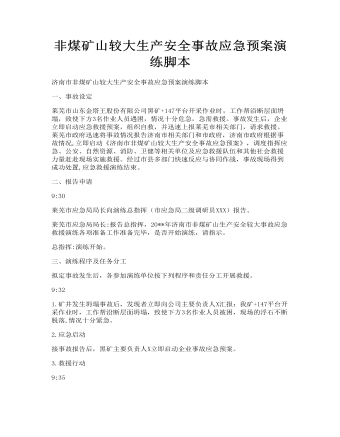
非煤矿山较大生产安全事故应急预案演练脚本
四、救援小组出动总指挥根据已经查明的事故现场情况,与各相关部门、专家、企业专业技术人员会商后立即作出以下决定:1.警戒保卫组,公安交警部门立即维护现场秩序,划出警戒区域;2.现场救援组,应急部门负责现场救援工作,指导矿山抢险救援人员营救被困人员,消防部门协助抢险救援工作;3.医疗救护组,卫健部门组织120救护人员对受伤人员进行现场紧急救护并送往医院;4.善后处理组,工会、民政、人力资源社会保障等部门及有关保险机构,配合当地政府做好善后处理工作;4.新闻宣传组,市委宣传部门做好新闻发布工作。
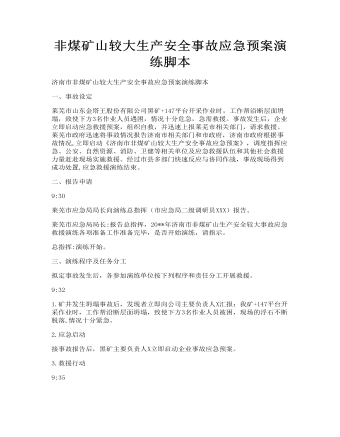
非煤矿山较大生产安全事故应急预案演练脚本
四、救援小组出动总指挥根据已经查明的事故现场情况,与各相关部门、专家、企业专业技术人员会商后立即作出以下决定:1.警戒保卫组,公安交警部门立即维护现场秩序,划出警戒区域;2.现场救援组,应急部门负责现场救援工作,指导矿山抢险救援人员营救被困人员,消防部门协助抢险救援工作;3.医疗救护组,卫健部门组织120救护人员对受伤人员进行现场紧急救护并送往医院;4.善后处理组,工会、民政、人力资源社会保障等部门及有关保险机构,配合当地政府做好善后处理工作;4.新闻宣传组,市委宣传部门做好新闻发布工作。
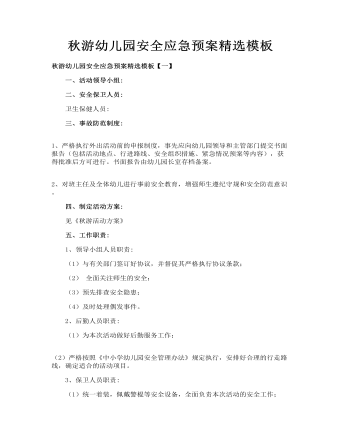
秋游幼儿园安全应急预案精选模板
五、工作职责: 1、领导小组人员职责: (1)与有关部门签订好协议,并督促其严格执行协议条款; (2) 全面关注师生的安全; (3)预先排查安全隐患; (4)及时处理偶发事件。 2、后勤人员职责: (1)为本次活动做好后勤服务工作; (2)严格按照《中小学幼儿园安全管理办法》规定执行,安排好合理的行走路线,确定适合的活动项目。 3、保卫人员职责: (1)统一着装,佩戴警棍等安全设备,全面负责本次活动的安全工作;
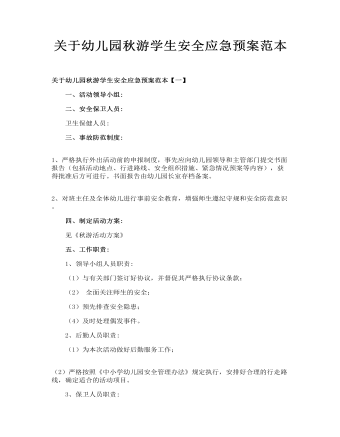
关于幼儿园秋游学生安全应急预案范本
1、牢固树立“安全第一,预防为主”的思想。活动前各班对幼儿进行专题安全教育,特别注意交通安全、饮食卫生、游戏安全等容易引发事故环节的安全教育,增强幼儿的安全意识和自我保护能力。 2、活动必须保持高度统一性,活动全过程(活动线路、集合、返幼儿园时间、安全规定等)服从活动领导小组的统一指挥。学幼儿园指派行政领导全程参与年级指导,班主任与配班教师共同做好本班组织管理工作。
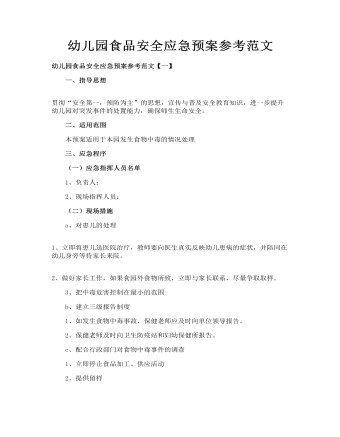
幼儿园食品安全应急预案参考范文
1、立即将患儿送医院治疗,教师要向医生真实反映幼儿患病的症状,并陪同在幼儿身旁等待家长来院。 2、做好家长工作,如果食园外食物所致,立即与家长联系,尽量争取取样。 3、把中毒危害控制在最小的范围 b、建立三级报告制度 1、如发生食物中毒事故,保健老师应及时向单位领导报告。 2、保健老师及时向卫生防疫站和妇幼保健所报告。

企业道路运输安全应急预案范文
(一)安全事故处置方案 1、发生安全生产事故,现场工作人员应立即采取处理措施,防止事故继续扩大并迅速报告; 2、总指挥根据事故报告立即到现场进行指挥,总指挥不在时由副总指挥负责指挥; 3、应急预案组织成员必须听从总指挥或副总指挥的统一调动和部署; 4、救护组进行现场救护,如有重伤人员应立即采取临时伤情处理并拨打急救电话送至医院抢救;现场工作人员施救时要注意自身安全和伤者再次受伤。
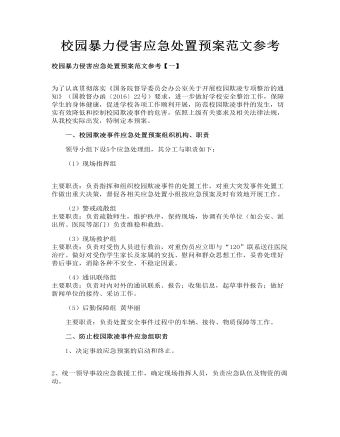
校园暴力侵害应急处置预案范文参考
一、校园欺凌事件应急处置预案组织机构、职责 领导小组下设5个应急处理组,其分工与职责如下: (1)现场指挥组 主要职责:负责指挥和组织校园欺凌事件的处置工作,对重大突发事件处置工作做出重大决策,督促各相关应急处置小组按应急预案及时有效地开展工作。 (2)警戒疏散组 主要职责:负责疏散师生,维护秩序,保持现场,协调有关单位(如公安、派出所、医院等部门)负责维稳和救助。 (3)现场救护组 主要职责:负责对受伤人员进行救治,对重伤员应立即与“120”联系送往医院治疗。做好对受伤学生家长及家属的安抚、慰问和群众思想工作,妥善处理好善后事宜,消除各种不安全、不稳定因素。 (4)通讯联络组 主要职责:负责对内对外的通讯联系、报告;收集信息,起草事件报告;做好新闻单位的接待、采访工作。


